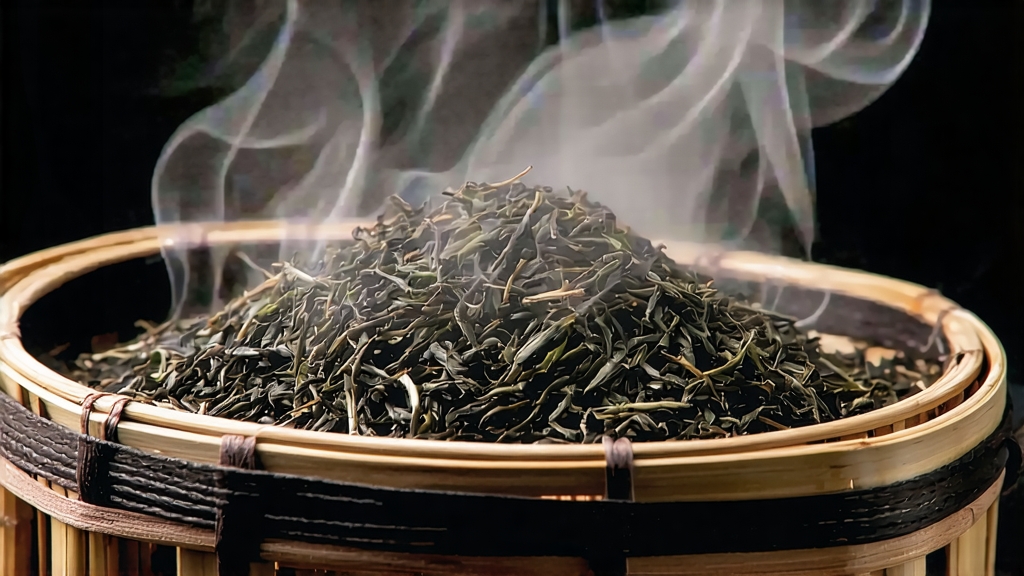
Tucked into the subtropical folds of southern China’s Guangxi Zhuang Autonomous Region, the small town of Liubao has given its name to one of the most intriguing yet under-celebrated members of the dark-tea family. To most Western drinkers, “dark tea” still evokes images of Yunnan’s shou pu-erh, but Liubao—older in written record, gentler in cup, and more intimate with the humid breath of camphor forests—deserves equal billing. This article invites the international palate on a complete journey through Liubao: its 1,500-year written history, the microterroirs that shape its flavor, the labor-intensive wet-piling craft that turns green leaf into midnight velvet, and the quiet rituals that coax its signature “betel-nut” fragrance into your porcelain.
-
From Tribute Caravans to Tea Trains: A Brief History
The earliest mention of “Liubao” as a tea appears in the Liu Song dynasty (420–479 CE), but its fame crystallized during the Qing era when the Jiaqing Emperor (1796–1820) placed it on the imperial tribute list. Compressed into 40-kilogram bamboo baskets, the tea left the Liu River wharf, traveled the ancient Tea-Horse Road’s southern spur, and descended to the Pearl River delta where clipper ships carried it to Southeast Asia. In Malaya’s tin mines and Singapore’s pepper plantations, Liubao became the working man’s balm against damp heat and malaria; dockworkers called it “kopi hitam Cina,” Chinese black coffee, because its thick liquor looked like java but calmed the stomach like tea. World War II disrupted the caravans, and Liubao receded into provincial obscurity until a late-1990s revival spearheaded by Guangxi tea scientists who re-isolated the indigenous “Golden Flower” Eurotium cristatum spores responsible for the tea’s mellow sweetness. -
Terroir: Where Humidity Writes Flavor
Guangxi lies at the same latitude as Havana, but monsoon clouds rolling off the South China Sea create a unique “wet heat” that rarely drops below 70 % relative humidity. Liubao Township sits at 200–500 m elevation on red lateritic soil rich in iron and aluminum oxides. The native cultivar—Camellia sinensis var. sinensis f. liubaoensis—bears small, thick leaves whose waxy cuticle evolved to resist fungal attack; that very thickness becomes the substrate for later microbial artistry. Surrounding forests of Chinese sweet gum and camphor emit terpenes that drift onto leaf surfaces, giving the finished tea a cooling, mint-eucalyptus echo impossible to replicate in dryer Yunnan or Hunan. -
Harvest Calendar: One Leaf, Five Seasons
Unlike spring-chasing green teas, Liubao prioritizes consistency over delicacy. Plucking begins in Qingming (early April) but continues through four additional flushes ending in late October. The most sought-after grade, “Guzhen” (ancient needle), uses only the first two leaves and a bud picked before 10 a.m. when dew still glistens. Larger “Siji” (four seasons) leaves, harvested mechanically after the solstice, form the backbone of mass-market bricks yet still deliver the hallmark sweet finish if processed with care. -
Craft: The Eight-Step Transformation
a. Wilting: Fresh leaf is spread 3 cm deep on bamboo trays in shaded sheds for 4–6 hours, reducing moisture to 68 %.
b. Kill-Green: A 3-minute 280 °C tumble in a heated drum deactivates polyphenol oxidase but preserves leaf integrity—shorter than green-tea kill-green to leave enzymes for later microbial feeding.
c. Rolling: A 35-minute light pressure roll twists the leaf into tight strips without rupturing every cell, creating micro-aerobic pockets.
d. First Drying: 15 minutes at 110 °C drops moisture to 18 %, producing “maocha” that smells like baked yam.
e. Wet Piling: The signature step. Maocha is re-sprayed with 28 % humidity water, piled 70 cm high under jute covers, and left for 25–35 days. Internal temperature climbs to 55 °C before workers “fan dui” (turn the pile) every five days, introducing oxygen that encourages Eurotium cristatum to bloom